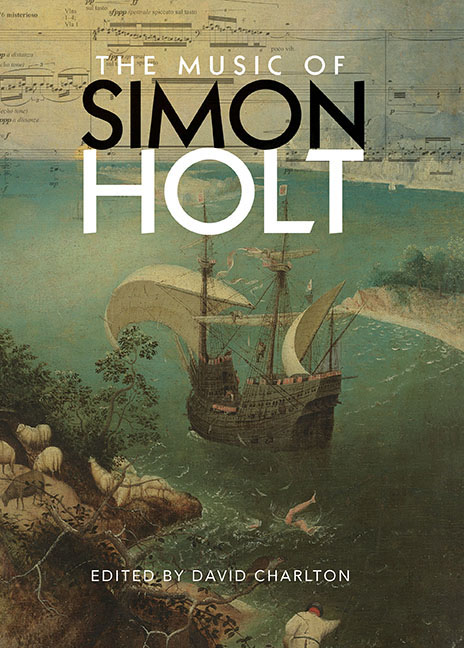Book contents
- Frontmatter
- Contents
- Figures and Tables
- Contributors
- Preface and Acknowledgements
- Abbreviations, with a note on recordings and scores
- Introduction Memories of Magical Moonlight: Simon Holt's years as a composition student
- 1 Duende y Duelos: The Andalusian spirit in the Lorca settings
- 2 An Interplay of Passion and Spirit: The Nightingale's to Blame
- 3 Images in Sound: Movement, harmony and colour in the early music
- 4 Myth and Narrative in 3 for Icarus
- 5 Sound, Sense and Syntax: The Emily Dickinson settings
- 6 Piano Music
- 7 Redefining the Cello's Voice: Musical agency in feet of clay
- 8 Performance and Reflections: Holt's music for oboe and cor anglais
- 9 Shaking the Bars: The Yellow Wallpaper
- 10 Listening to the River's Roar: Stance, texture and space in the concertos
- 11 Orchestral Works in Performance
- 12 Oblique Themes and Still Centres: A conversation between
- 13 Sketching and Idea-Gathering
- 14 Art, Conceptualism and Politics in Holt's music
- Appendix A Overview and Catalogue of Pieces
- Appendix B Texts by Simon Holt for Raju Raghuvanshi is a ghost and The Legend of Melusine
- Bibliography
- Index of pieces by Simon Holt
- General index
10 - Listening to the River's Roar: Stance, texture and space in the concertos
Published online by Cambridge University Press: 01 September 2018
- Frontmatter
- Contents
- Figures and Tables
- Contributors
- Preface and Acknowledgements
- Abbreviations, with a note on recordings and scores
- Introduction Memories of Magical Moonlight: Simon Holt's years as a composition student
- 1 Duende y Duelos: The Andalusian spirit in the Lorca settings
- 2 An Interplay of Passion and Spirit: The Nightingale's to Blame
- 3 Images in Sound: Movement, harmony and colour in the early music
- 4 Myth and Narrative in 3 for Icarus
- 5 Sound, Sense and Syntax: The Emily Dickinson settings
- 6 Piano Music
- 7 Redefining the Cello's Voice: Musical agency in feet of clay
- 8 Performance and Reflections: Holt's music for oboe and cor anglais
- 9 Shaking the Bars: The Yellow Wallpaper
- 10 Listening to the River's Roar: Stance, texture and space in the concertos
- 11 Orchestral Works in Performance
- 12 Oblique Themes and Still Centres: A conversation between
- 13 Sketching and Idea-Gathering
- 14 Art, Conceptualism and Politics in Holt's music
- Appendix A Overview and Catalogue of Pieces
- Appendix B Texts by Simon Holt for Raju Raghuvanshi is a ghost and The Legend of Melusine
- Bibliography
- Index of pieces by Simon Holt
- General index
Summary
Deep Listening by Pauline Oliveros … is my desert island disc. I only listen to it occasionally as I want to keep it special. It was recorded in the vast two-million-gallon underground water cistern in Fort Worden, Washington, which has a forty-five second reverberation time…. It's unlike anything else, but apart from that essential avantgarde credential, it also happens to be deeply moving and devastatingly powerful. Sweeps all before it.
The fields we are concerned with are, first, the physical – nature, the Cosmos; secondly, the mental, including logical and formal abstractions; and, thirdly, the social. In other words, we are concerned with logicoepistemological space, the space of social practice, the space occupied by sensory phenomena, including products of the imagination such as projects and projections, symbols and utopias.
THIS CHAPTER IS CONCERNED with ways in which stance and texture produce physical and virtual space in Simon Holt's concertos composed or revised since 2000, and with how such processes shape listener perception of the music's subject position – by which I mean the idea, proposed by Naomi Cumming, that ‘[t]here is a “subjectivity” in the work itself, with which a listener may become actively engaged, not following his or her impulses, but guided by those of the work’. Motivated by a range of cultural-theoretical models, in particular the concept of stance developed by Harris M. Berger, Henri Lefebvre's work on the phenomenology of space, especially his notion of ‘counter-spaces’ of resistance, and Denis Smalley's theory of ‘space-form’, I will explore ways in which Holt's concertos adopt certain postures, and ask how these are constructed and made available to perception.
Holt's concertos naturally raise questions about the relationship between soloist, orchestra and listener. On the one hand, Holt moves wilfully in the Romantic direction of clearly foregrounded soloists with directly expressive, fiercely virtuosic parts. On the other, his ensembles generate sometimes dense, at other times finely calibrated concertante textures that are utterly contemporary. Holt's music from the 1980s and 1990s often evokes intense psychological states, such as rage (although, as will be seen, what matters more is Holt's attitude, or stance, towards that emotion).
- Type
- Chapter
- Information
- The Music of Simon Holt , pp. 194 - 231Publisher: Boydell & BrewerPrint publication year: 2017

